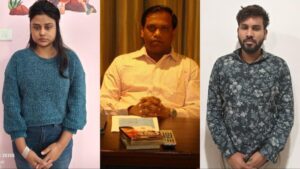Manish Sisodia Targeted By CBI, 8-Point Guide To His Much-Praised Career
[ad_1]

Manish Sisodia is known for reforms in education sector and increasing the number of Mohalla Clinics.
The CBI on Friday carried out searches at the residence of Delhi Deputy Chief Minister Manish Sisodia after registering a case over allegations of corruption in AAP government’s Excise Policy. The agency has searched 21 locations across India.
Here are eight points on Manish Sisodia’s career:
-
Manish Sisodia is an activist who came to prominence during the Jan Lokpal agitation. He got a diploma in journalism from the Bharatiya Vidya Bhawan in 1993 and worked with television channel Zee News and then All India Radio. Mr Sisodia quit journalism in 2006 to participate in the agitation for Right To Information.
-
Mr Sisodia was a key member of the team that laid the foundation of the Jan Lokpal Andolan, led by Gandhian activist Anna Hazare. He sat on fast for 10 days demanding setting up of a Special Investigation Team (SIT) to probe cases against corrupt Union ministers. Mr Sisodia was also sent to jail with Mr Hazare during anti-graft agitation.
-
He established a non-governmental organisation ‘Kabir’ in Delhi to spread awareness about RTI and also became an active volunteer of NGO Parivartan. The second NGO worked towards improving the transparency in public dealings of the Income Tax department and its members even organised a satyagraha outside the Chief Commissioner’s office. Parivartan also launched a campaign that led to a court order directing private schools, which had received public land at discounted prices, to admit poor kids without fee.
-
The 50-year-old has always been at the side of Mr Kejriwal ever since the latter launched AAP in 2012. He is credited with strengthening the party at the grassroots level after it lost all seven parliamentary constituencies in the Lok Sabha elections to the BJP in 2014.
-
Mr Sisodia won from the Patparganj constituency in the February 2015 Assembly election in Delhi, defeating the BJP’s Vinod Kumar Binny by over 28,761 votes. The BJP had won the Patparganj seat in 1993. After that, it became a Congress stronghold until Mr Sisodia won the seat in 2013 and 2015. In 2020 Delhi Legislative Assembly election, he again defeated Ravinder Singh Negi, a BJP candidate by about 3,000 votes.
-
Since the time AAP came to power in Delhi, Mr Sisodia has brought in radical reforms to the education system in Delhi. One of the earliest decisions he took after becoming Delhi’s Finance Minister in 2015 was to double the funding for public education programme. Some of the major reforms carried out under Mr Sisodia are establishment of modern classrooms equipped with tech-based teaching aids, football fields, field hockey turfs, auditoriums and science laboratories. The AAP government also formed parent’s led management committees to create accountability and successfully conducted parent-teacher meetings (PTMs) on a large scale.
-
Another major reform by the AAP government, which received praised from global leaders, are Mohalla Clinics or primary health centres. They have been established to provide a basic package of essential health services including medicines, diagnostics, and consultation free of cost. The health centres have been established in various mohallas (neighbourhood) across Delhi to reduce the financial burden on low-income households by saving travel costs and lost wages. During COVID-19, these clinics doubled up as vaccination centres. There are 519 mohalla clinics in Delhi so far and Mr Sisodia announced in June that 100 more will be added soon.
-
He is a cabinet minister in the third Arvind Kejriwal government and holds charge of a number of departments and also oversees the Excise department. In June, after the arrest of another AAP minister Satyendar Jain, Mr Sisodia was given the additional charge of Health, Home, Power, and Water and Industries. On Friday, when the CBI conducted the raid, Delhi Chief Minister Arvind Kejriwal posted a photo of New York Times front page with a photo of Mr Sisodia along with a story on the education reforms taken by Delhi government.
[ad_2]
Source link








